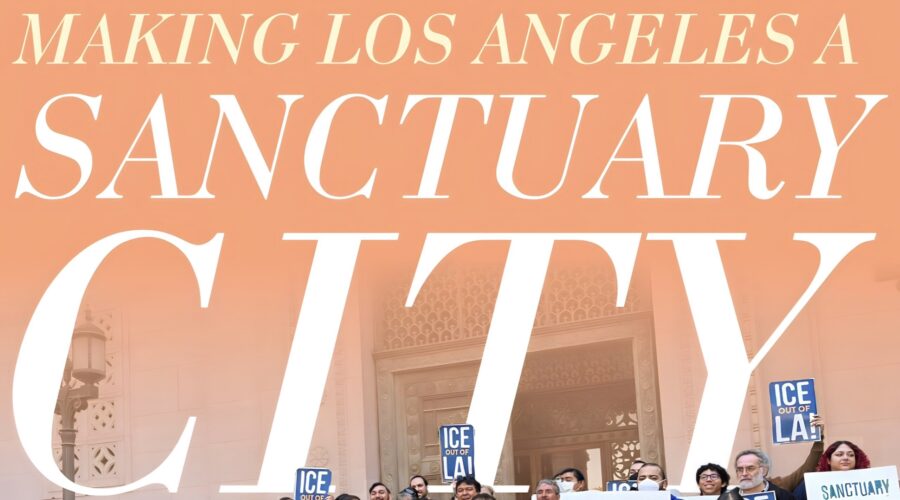WITH DEGREES FROM HARVARD AND MIT and the charismatic charm of a Bollywood star, Nithya Raman could have stepped out of Indian cinema. Instead her tenure on the Los Angeles City Council has been like a page out of Ghandian politics.
Raman’s first on the council has been marked by quixotic campaigns using her political clout as an instrument for the uplift of mankind in social, economic, moral and spiritual spheres — most dramatically now as one of the driving forces to make Los Angeles a sanctuary city for undocumented immigrants.
“Immigrants make up the very fabric of LA,” says Raman, who was born in Kerala, India, and moved to the U.S. when she was six. “Prohibiting the use of city resources for federal immigration enforcement shouldn’t depend on executive actions that can be overturned by a future administration. These are fundamental protections that should be enshrined in our laws.”
Raman and her fellow councilmembers have championed the making of Los Angeles as a sanctuary city — Eunisses Hernandez and Hugo Soto-Martinez — saw their proposed measure take another major step toward realization.
The city’s Police Commission late last year approved a report providing details of the Los Angeles Police Department’s continued commitment to not enforce immigration law, as city officials prepare to bring forth an ordinance officially making L.A. a sanctuary city for undocumented immigrants.
Commissioners unanimously voted to approve an annual report intended to ensure that the department does not participate in any enforcement actions involving immigration status violations.
According to the report, the LAPD received 783 detainer requests from the U.S. Immigration and Customs Enforcement in 2022 — none of which were honored.
The report also includes a breakdown of various joint task forces involving the LAPD and other law enforcement agencies conducted in 2022. In each case, no people were arrested for immigration enforcement purposes.

“Our top priority is public safety and building of trust, and the demonstration of our agency’s transparency and outreach to all our immigrant communities,” police officials said. “Our ongoing focus is to ensure the victims and witnesses are not afraid to contact the police, report crime or become witnesses as necessary, regardless of their immigration status.
“Our focus will always be to maximize public safety for all.”
Police officials said they work with federal law enforcement agencies, include ICE and Homeland Security, on various operations to “help eliminate crimes impacting vulnerable communities.” The law enforcement agencies work to address human trafficking, child pornography and other crimes, officials said.
The LAPD participates in 20 interagency task forces, and in 2022 those task forces made 941 arrests. LAPD officials reiterated that none of those arrests was related to immigration enforcement.
The report stated that the LAPD continues to comply with its Immigration Enforcement Procedures, a notice published by the Office of the Chief of Police reinforcing the department’s commitment to the California Values Act.
That act, which took effect in January 2018, prevents California law enforcement agencies, including the LAPD, from using resources on behalf of federal immigration enforcement agencies. The law says certain sites such as schools, hospitals and courthouses are “safe spaces” for everyone in the community.
In addition, the LAPD in subsequent years refined its policies to remove questions related to a person’s place of birth, unless warranted for an investigation of a criminal offense.
However, police said that anyone suspected of committing a crime is fingerprinted through the decentralized automated booking system and automated entry. Suspect are automatically entered into the National Crime Information Center, which is accessible to local, state and federal law enforcement agencies.
The department’s report comes at a time when the Los Angeles City Council is working to officially make Los Angeles a sanctuary city for immigrants who are in the United States illegally.
While the City Council has previously passed a symbolic resolution declaring Los Angeles a “City of Sanctuary,” it has not codified sanctuary policies into municipal law.
But last June, the council approved the motion proposed by Raman, Hernandez and Soto-Martinez that directs the city attorney to prepare an ordinance within 60 days that would permanently enshrine sanctuary policies into municipal law and ensure that no city resources, property, or personnel are used for federal immigration enforcement.
It also directs City departments to report back with recommendations to close gaps in existing policy to limit direct and indirect data sharing with federal immigration authorities and contracted private companies engaged in immigration enforcement activities.
“As the daughter of immigrants, who was born and raised in a city that was built by — and continues to thrive — because of our immigrant community, I am proud to see Los Angeles take this long overdue step to codify protections for our undocumented residents, said Hernandez.
“Our immigrant communities make up the nervous system of Los Angeles. They need more than symbolic gestures and internal policies that can change from administration to administration. They need lasting protections that are enshrined into City law. It’s time for LA to finally become a true Sanctuary City.”
Soto-Martinez said, “one in ten Angelenos are undocumented, and this community needs to be able to trust the government and access critical services just like anyone else.”
But it may be Raman who is finding this as an early crowning achievement in a career she has dedicated to social justice including proposed reforms to Los Angeles’ housing and homelessness policy and now immigration.
“Immigrants make up the very fabric of this city,” she said. “Prohibiting the use of city resources for federal immigration enforcement shouldn’t depend only on executive actions that could be overturned by a future mayor or police chief. These are fundamental protections that should be enshrined in our laws going forward.”





